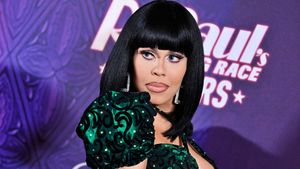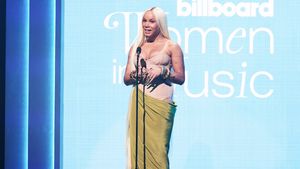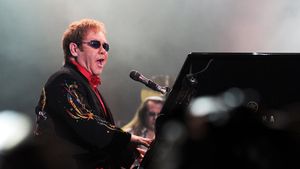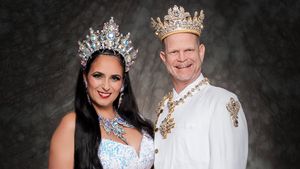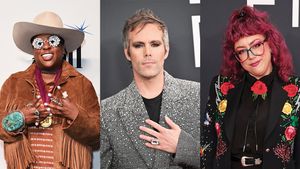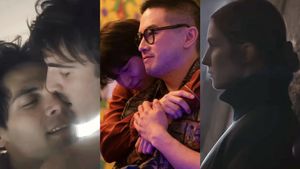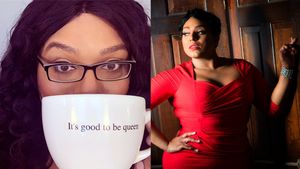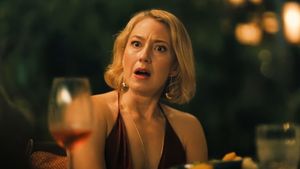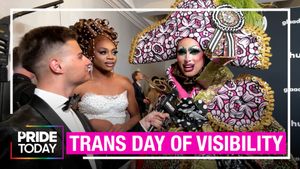Though straight
writer/director Rawson Marshall Thurber made his feature
debut with the goofy Dodgeball: A True Underdog
Story, his follow-up is something very different
entirely -- an adaptation of Pulitzer
Prize-winner Michael Chabon's first novel,
The Mysteries of Pittsburgh. Beloved for its
forthright, literate presentation of a bisexual love
triangle among college-age bohemians, the book
languished in development until Thurber's
radical adaptation got the green light. I talked to Thurber
on the eve of the film's premiere at the
Sundance Film Festival to find out how he talked
Chabon into his revision, and whether he's worried
about how fans might react.
Other directors (such as Alan J. Pakula) have tried
to bring this book to the screen. One attempt, staring
Jason Schwartzman, almost made it to shooting. How
did you get ahold of the project?
I knew that it
had been around for a while--I read the book in 1995
and fell in love with it. I wrote Michael Chabon a fan
letter, essentially saying, "I love this book,
I love your writing, and I'd love to take you
to breakfast to talk about it." He's
represented by the same agency as I am, so I flew up
to the Bay Area -- where I'm from -- and we went to
this local joint up there, had some eggs, and I
expressed my passion for it.
Was he receptive?
You know, Michael
Chabon is just about the coolest Pulitzer
Prize-winning author you'll ever meet.
He had tried to adapt it before -- it was the first
script he'd ever written, and he kind of ran into a
tree. I think the novel had gotten this rap for being
unadaptable.
I know you had a very different take on how to
adapt the book. How did you sell him on it?
I knew what I
wanted to do, and I told him, "I've got a
pretty radical take on it, and if you're at all
interested, let me do a five-or six-page treatment. If
you're interested in that, let's go do it, and
if you're not, please say so, and I'm a
big fan and I can't wait to read the next
thing." I wrote it up and sent if off, and I never
thought he would say yes, actually, but then he read
it and he sent me an e-mail back saying,
"It's great -- let's do
it."
Let's talk about some of the big changes
you've made in your adaptation. In the
book, the main character, Art (played in the film
by Jon Foster), is romantically linked to his
girlfriend, Phlox, his best friend,
Arthur, and there's interest in a
third character, Cleveland. In your version, Phlox
is now a supporting character and Arthur
has been excised entirely. Instead you have
promoted supporting charactersJane (Sienna Miller) and Cleveland (Peter
Sarsgaard) to Art's love interests and they now
form a romantic triangle. And you have changed
Cleveland's sexuality from straight to bi to make
this work. Why did you have to make so many
changes to the book?
This is something
that was front and center in my treatment: the novel
works beautifully, but part of the struggle in adapting it
for film is that the engine of the novel is a
four-pointed "love rhombus," which
isn't as efficient a shape as a triangle for cinema.
Also, the novel is told in the first person, which is
always inherently difficult to adapt. Art Bechstein in
the novel is interesting because he's telling this
story, because he's imbued by Michael Chabon's
powers of observation and description. Were you to
adapt that directly, you end up with a passive main
character.
But why so many character replacements? Why sub in
Cleveland -- a character who was previously straight --
for Arthur?
You know, that
was really interesting to me: someone falling in love
irrespective of gender. I found that fascinating. It was
clear to me that Art loved Arthur and Phlox, but he
did love Cleveland as well -- he says as much in the
final third of the novel. It seemed more efficient to me
to fashion a love triangle with both people, and I think,
also, it would allow me to stay true to the tone,
tenor, and spirit of the novel.
Had you thought about doing it the other way around
-- replacing Cleveland with Arthur?
That's a
really good question. Certainly, Cleveland brings with him
more plot, in that he's mixed up with the
gangster world, and certainly brings with him the
whole third act of the novel. I thought to do it that way
instead of the other way around gave it more drive.
Similarly, why has Phlox -- the female lead of the
novel -- turned into a supporting role in favor of Jane,
who plays a very minor role in the book as
Cleveland's on/off girlfriend?
I think that
Phlox still exists in a very similar manner to the character
she was in the novel -- someone who's deeply
passionate and wonderful. And I think that
Art's relationship with Phlox in the novel is similar
to what it is in the film, in that Art's not
sure why he's with her, and she takes
everything so terribly seriously. I think [Phlox's
new role] was Michael Chabon's idea, actually,
because I was going to have the drive of the narrative
be between Jane, Cleveland, and Art, and I didn't
want to lose Phlox.
In terms of Jane,
I remember talking to Michael about it. I think he had
felt that he didn't do all he could with that
character, who was so great and had such a lovely
introduction in the novel. I took some of those
elements of Phlox and gave them to Jane and strengthened the
character, and then repurposed Phlox.
There is a lot of controversy online amongst Chabon
fans who've caught wind of all the changes. Was
that on your mind at all when you were doing your adaptation?
[Laughs]
You know, Kyle, for better or for worse, I actually
didn't really think about getting beaten up one way
or the other. My real goal was to make a film that
felt like the novel did to me, and I think I've
done that. In terms of the bisexuality, I did my best with
it. Art, in the novel, was unsure of his
sexuality. In the early bits, he had always worried
that he might be gay and took it sort of sharply and never
let anyone mock him for that. In the film you see a similar
thing -- Art is unsure about whom he loves and why he
loves, but it's how he loves that ends up being
the important thing. If people come to the film
expecting to see a direct transcription of the novel, this
isn't the one for them, but if they're
coming to see a movie that feels like the book and has
that sense of memory and beauty and nostalgia, I think
they'll be pleased.




















